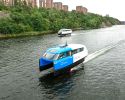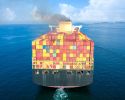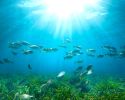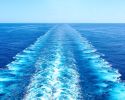Now, the propeller and hull can be optimized for sea conditions

Improved energy efficiency will matter more for the reduction of shipping emissions in the coming ten years than new green fuels. The right combination of hull and propeller can, for an example, save fuel. A research project within the Transport Administration's program Sustainable Shipping, driven by Lighthouse, has for the first time measured how well propeller and hull perform together in waves.
The wind is blowing at sea, and the boat is rocking. Of course, the ships' propellers and hulls have been optimized for different types of waves? No, it’s not that simple. The hulls of larger ships are designed separately, as are the propellers, which are fitted in a little later. At best, they are tested to function optimally in calm waters. Simplified, this is generally how the industry designs ships.
This is understandable. Determining how the propeller and hull perform optimally is not easy, even in calm waters. In waves, it has previously been nearly impossible, and it is only now that computers are powerful enough to perform simulations of flow around waves. Just calculating a single specific wavelength and the interaction effects between the propeller and hull takes one to two weeks, even on a high-performance computer system with hundreds of thousands of computing cores.
– In the first part of the project, we measured how the hull moves in waves, in the second, how the propeller performs in waves compared to calm water. In the final phase, we looked at how the propeller and hull work together in waves, says Arash Eslamdoost, a researcher at Chalmers who led the research project Propeller-Hull Interaction Effects in Waves.
The main purpose of the project is to improve the design of fuel-efficient ships by accurately predicting power needs, taking into account interactions between various ship components such as the hull, propeller, appendages, and machinery. This focus is more relevant today than when the project started five years ago. Back then, the discussion mostly revolved around alternative fuels as the solution to shipping's transition. Today, as the EU has implemented and the IMO is expected to introduce stricter regulations for a faster transition, there is an increasing emphasis on the significance of energy efficiency for achieving climate goals.
– We must focus on energy efficiency. That is how we can most easily reduce emissions. And there are numerous technologies for this, said Eirik Ovrum from DNV when DNV’s Maritime Forecast to 2050 was launched last week.
Improvements to hulls, propellers, and engines could reduce fuel consumption by 4 to 16 percent by 2030, according to Ovrum and DNV. The project led by Arash Eslamdoost could thus contribute to those figures.
– We know that the propeller's power varies in waves and loses performance. Our work explains why and how this happens. Why higher power is needed, says Arash Eslamdoost.
Using numerical simulations at model scale, the research explains how the propeller and hull work together in regular head wave conditions. This opens new opportunities for the industry.
– Every large ship's propeller has a unique design based on the hull shape and the speed it is intended to achieve in calm waters. Now it would be possible to design the propeller and hull based on the type of waves it will sail in.
So how much fuel could be saved with this?
– I can state that fuel consumption will be reduced, but we have not redesigned any propeller or conducted for such an analysis. Therefore, it is difficult to provide an exact figure without performing simulations with an updated propeller design for waves, but I estimate a potential reduction in fuel consumption of 3-5%. We are in ongoing discussions with our industry partners to redesign a propeller for waves and perform new simulations to predict the gains more accurately.
-
 Ny studie: Eldrivna pendelbåtar kan effektivisera Stockholms kollektivtrafik
Ny studie: Eldrivna pendelbåtar kan effektivisera Stockholms kollektivtrafik -
 EU: Sjöfartens utsläpp ökar
EU: Sjöfartens utsläpp ökar -
 Sociala relationer påverkar val av bränsle
Sociala relationer påverkar val av bränsle -
 Sjöfartens omställning kräver ”mjukare” påtryckningar
Sjöfartens omställning kräver ”mjukare” påtryckningar -
 Hon hade avtalad tid med Kapten ynkrygg
Hon hade avtalad tid med Kapten ynkrygg -
 Lighthouse omvärldsanalys 2025 – osäkerhet och tullar präglar sjöfarten
Lighthouse omvärldsanalys 2025 – osäkerhet och tullar präglar sjöfarten -
 Se seminariet Shipping in the Marine Environment
Se seminariet Shipping in the Marine Environment -
 Vad betyder egentligen de 90 procenten?
Vad betyder egentligen de 90 procenten? -
 Hålla där...
Hålla där... -
 Ny rapport: Klimatförändringarna ett hot mot de flesta större hamnar i världen
Ny rapport: Klimatförändringarna ett hot mot de flesta större hamnar i världen

